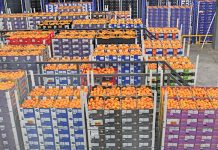
The first harvest estimate for South Africa’s maize and other summer grains points to a vastly smaller crop, potentially leading to food-price inflation that is likely to fuel overall inflation. This will hit the poorest consumers hardest. White maize is a staple food in South Africa, while yellow maize comprises more than 60% of the feed rations given to chickens, the country’s cheapest source of protein.
Food comprises 14,2% of Statistics SA’s consumer price index basket of goods and services, both of which are taken into account when measuring inflation. Last year, food price inflation accelerated to reach a high of 9,5% in August, driven by the price of meat and unprocessed food, which contribute 84% of the food basket and almost 12% of the overall index.
This means that a 10% increase in the price of unprocessed food and meat would relate to a 1,2 percentage point additional contribution to overall inflation.
Reduced by a third
With the maize crop for 2015 forecast to be a third lower than last year’s, which was the country’s largest since 1981, local prices are certain to rise, putting pressure on overall food prices, according to Mike Schüssler, economist at Economists.co.za.
“Maize prices have the largest impact on food products,” says Schüssler. “It’s a staple feed of the majority of South Africans, it’s the largest ingredient in chicken feed, and dairy farmers use it in their feed rations.”
The Crop Estimates Committee’s first production forecast for the 2015 season saw a 39% decline in the expected white maize harvest, from 7,7 million tons last year to 4,7 million tons. The yellow maize crop would probably be 24% lower at 4,9 million tons, down from 6,5 million tons last year.
The Free State is expected to harvest 3,9 million tons of maize compared with 6,2 million tons last year – a 37% drop. North West would probably produce a 1,5 million ton crop, down 46% from last year’s 2,9 million tons. These provinces are the largest maize producers in the country.
“We expect 50% of the average crop this year,” says Danie Marais, managing director of Lichtenburg-based agribusiness NWK. “Our income will definitely be lower.”
The contract price of white maize for future delivery on the SA Futures Exchange rose 23% over the past three months, from R2 155/t to R2 639/t, reaching a high of R2 998/t on 16 February. The contract price of yellow maize gained 11% over the period, from R2 167/t to R2 400/t, and climbed to a high of R2 550/t on 16 February.
Global maize production
It is estimated that global maize production this year will increase to 991 million tons from 989 million tons in the previous marketing season, according to the US Department of Agriculture’s (USDA) latest world agricultural supply and demand estimates, published last month.
The report indicated that South Africa would harvest a 13,5 million ton maize crop. This will now be lowered to 9,6 million tons, a decrease of almost four million tons. It is estimated that the US will produce a 361 million ton maize crop this year, China a 216 million ton crop, and Brazil 75 million tons.
The projection for the world’s maize-starting stocks was adjusted upwards to 173,8 million tons in February, up from 172,2 million tons in January. With opening stocks of 173,8 million tons, estimated production of 991 million tons and world consumption of 975 million tons, the 2015/2016 season is forecast to end with closing stocks of 189 million tons, more than the opening stocks, according to the USDA estimates.
As global production
and opening stocks are forecast to meet consumption demand in the 2015/2016 season, the dollar price for maize has remained little changed. The Morningstar Corn Commodity Index, which tracks various maize contracts for delivery, declined by 2% to 26,53 points over the past three months.
Increased yellow maize imports
Owing to the smaller crop, South Africa is estimated to import about 600 000t of yellow maize between March this year and April 2016, according to the National Agricultural Marketing Council’s (NAMC) latest estimates of supply and demand of grains.Should animal feed companies switch their 350 000t of white maize usage to yellow maize over the period, the country could see yellow maize imports of up to 900 000t, the council says.
- Higher prices
“It is expected that the current drought situation will push maize prices higher due to the fact that imports will increase,”
the NAMC report warned. The price of maize imports could also be influenced by the value of the rand.
“A weakening rand can add to the cost of imported maize,” Schüssler says.
The rand lost 2,1% against the dollar over the past three months and traded at around R11,81 for a dollar, compared with R11,54 at the start of December. Most maize futures contracts are priced in dollars and the SA maize price is derived from these. A weaker rand will support higher local prices.
- Weaker rand
A large swing from exports of maize from South Africa to imports into the country will have an impact on the rand, Schüssler explains. Higher imports will widen the country’s already large current-account deficit, which is the difference between the export earnings of goods and services and the import payments for goods and services.
Following last year’s bumper crop of 14,25 million tons of maize and lower exports, South Africa will start its 2015/2016 marketing season with ample stock levels. The expected white maize opening stock is estimated at 1,28 million tons, according to NAMC.
With forecast commercial deliveries of 4,5 million tons, the available supply will be 5,9 million tons. People consume 4,4 million tons of white maize annually, the council said.White maize for animal feed will probably drop from 1,45 million tons
to 350 000t in 2015/2016, as feed producers switch to yellow maize for rations.
The estimated opening stock for yellow maize is one million tons, according to NAMC. Commercial deliveries of 4,6 million tons will bring the total supply, excluding potential imports, to 5,6 million tons in 2015/2016. Some 4,48 million tons are needed for the animal-feed industry in this marketing season, compared with 3,34 million tons last season, as yellow maize is substituted for white maize.
A tight supply of maize would inevitably lead to a slump in exports of the crop, according to Isaac Matshego, economist at Nedbank. “Our maize exports will fall and may have a negative impact on the rand,” he says. Lower export earnings will widen South Africa’s current-account deficit with the rest of the world, placing pressure on the value of the rand as less of the local currency is demanded.
- Increased inflation
Higher food prices, especially in terms of higher mealie-meal prices, would have an effect on inflation, Matshego says.
“It may prompt the Reserve Bank to hike interest rates moderately.” However, he says that given the country’s lacklustre economic growth, hampered by rolling power cuts and difficulties in the labour market, the Reserve Bank should not increase interest rates.
Nedbank expects a 0,25 percentage point increase in November, according to him. Consumer price inflation breached the upper limit of the Reserve Bank’s 3% to 6% target between March and August last year and decelerated sharply to 4,4% in January, Statistics SA reported.
Amid the prospects of higher interest rates by the end of the year, farmers will in the meantime start to struggle to repay debt, NWK’s Marais says. Businesses reliant on maize producers in those areas hit by the drought would struggle this year, says Schüssler.
“Sales of durable goods and investment in the drought-stricken areas will be hit. You’ll see it in businesses putting up sheds and selling tractors, for example.” Marais says that the drought’s effect on smaller towns in the North West and Free State is worrying. “Farmers don’t buy capital goods. We are very dependent on the farming community.”













